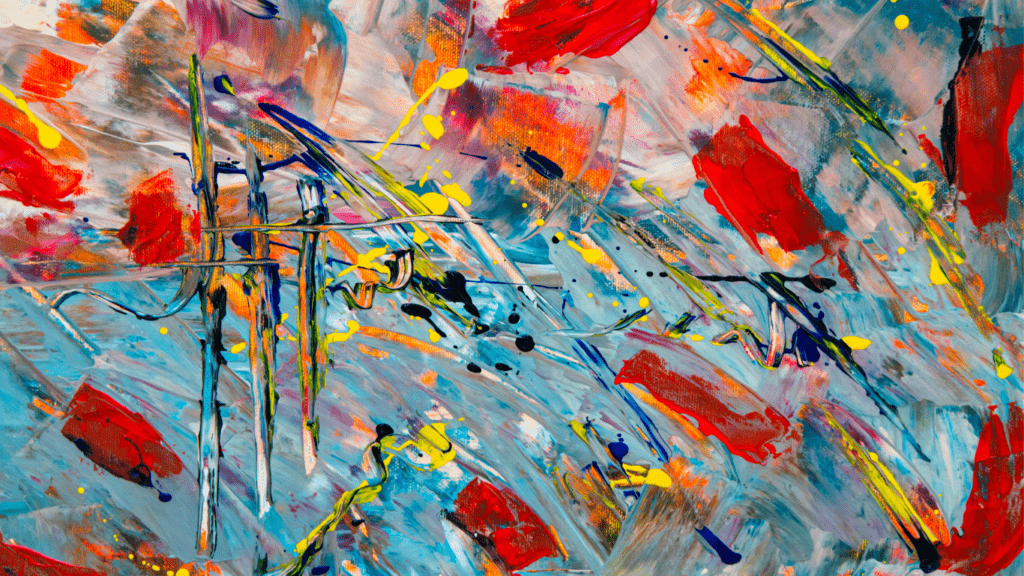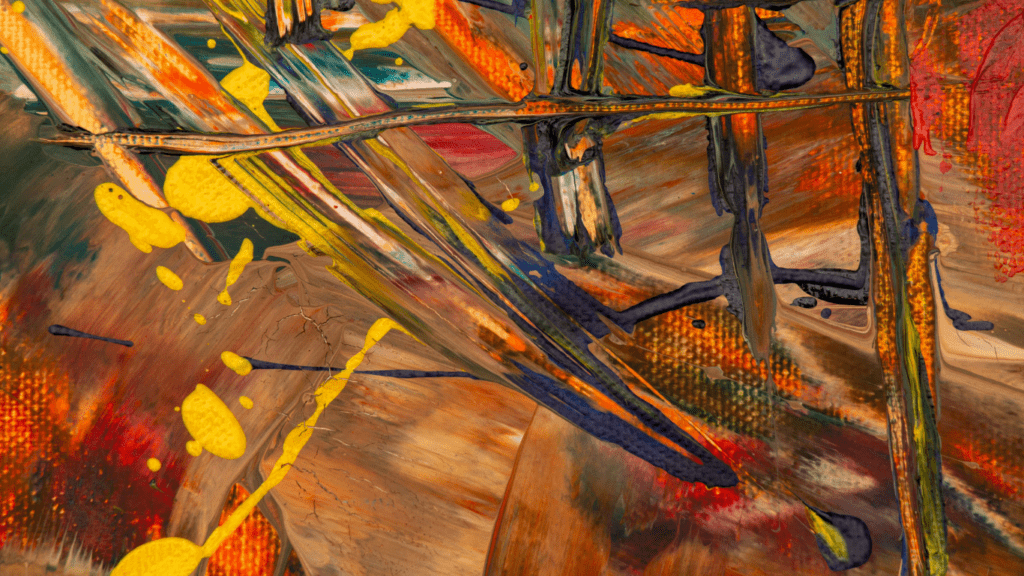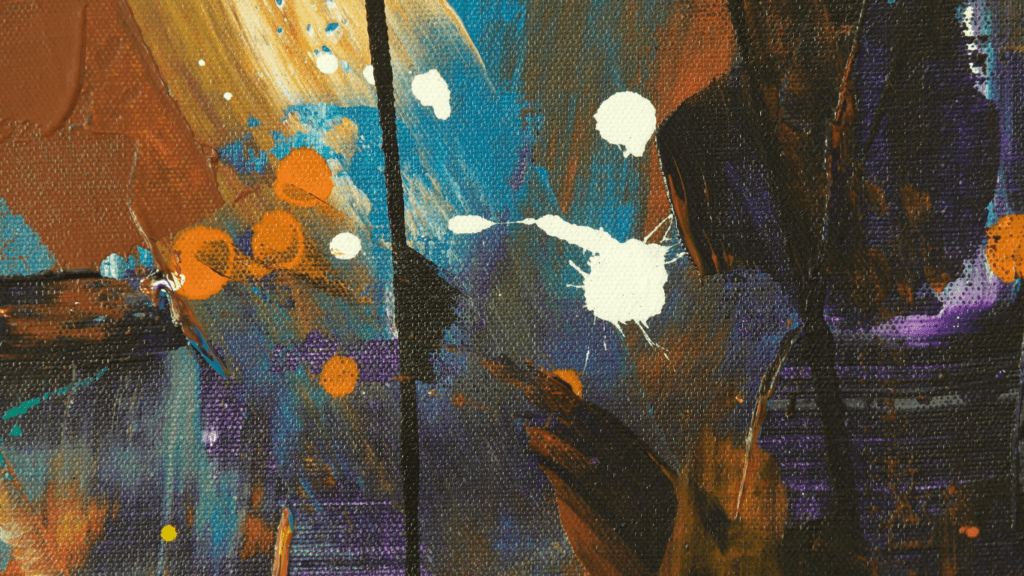Origins Of Abstract Expressionism
Abstract Expressionism emerged in the mid-20th century, representing a major shift in creative expression. It sprang forth from a time of global turmoil and change, particularly influenced by World War II.
Historical Context
During the 1940s and 1950s, Abstract Expressionism developed primarily in New York City. The devastation of World War II prompted many European artists to emigrate to the United States. Major cities, particularly New York, became cultural havens for these artists. They brought diverse perspectives and methods, blending with American ideas to create something unique.
This period saw a surge in artistic experimentation. Economic growth after the war provided resources and audiences for new forms of art. This led the U.S. to become a new center of the art world, pushing New York to prominence over Paris. Artists sought to express individual perspectives deeply tied to the contemporary human condition, focusing less on traditional representations and more on emotional depth.
Key Influences
Several key factors shaped Abstract Expressionism. European modernism significantly impacted its development. Artists like Wassily Kandinsky and Joan Miró, known for their abstract works, pioneered non-representational art, laying the groundwork for Abstract Expressionism.
The Surrealist movement also played a crucial role. Surrealist artists like Max Ernst and André Breton explored the subconscious mind and spontaneous creation, principles that Abstract Expressionism adopted and expanded.
Psychological theories from figures such as Carl Jung influenced artists by encouraging exploration of the inner psyche through art. Jung’s collective unconscious and archetypes provided tools for delving into universal human experiences, resonating strongly with abstract expressionists.
Abstract Expressionism also drew from American traditions, including the rugged individualism epitomized by the frontier spirit. This individuality was reflected in the distinct personal styles of each artist within the movement.
Finally, the political climate of the Cold War era pushed artists to explore freedom and personal expression, contrasting the conformity and repression they saw around them. They used art as a means of challenging and portraying these complex social dynamics.
Major Artists And Their Contributions
Central figures in Abstract Expressionism played a vital role in shaping the movement and influencing contemporary art. Understanding their unique contributions adds depth to any exploration of this pivotal era in art history.
Jackson Pollock
Jackson Pollock pioneered the drip painting technique, revolutionizing art with his innovative methods. His approach involved dripping or pouring paint onto a horizontal surface, allowing gravity and motion to dictate the flow. “No. 5, 1948” stands out among his masterpieces, showcasing complex layers of color and texture. Pollock’s work emphasized spontaneity and embraced chaos, rejecting traditional brushstrokes for a more dynamic interaction with the canvas. Time magazine famously dubbed him “Jack the Dripper,” highlighting his unconventional style.
Mark Rothko
Mark Rothko is best known for his color field paintings, which feature large, luminous blocks of color. Rothko’s compositions invite viewers into contemplative spaces by using subtleties of color and form. Works like “Orange and Yellow” exemplify his focus on emotional depth and simplicity. Unlike Pollock’s kinetic energy, Rothko’s paintings promote tranquility and introspection. He sought to evoke profound contemplation through the sublime power of color, stripping away distractions to let the artwork speak directly to human emotions.
Willem de Kooning
Willem de Kooning combined elements of figurative and abstract art, creating intense, energetic works. His most famous series, “Women,” merged abstract forms with human figures, highlighting his complex approach. Paintings like “Woman I” blend aggressive brushstrokes and vibrant colors, capturing raw emotion and movement. De Kooning’s expressionistic style focused on blending chaos and form, making his pieces a unique juxtaposition of structure and spontaneity. His art continuously evolved, reflecting his ability to adapt and experiment.
These artists exemplify the essence of Abstract Expressionism, each contributing distinctively to the movement’s diversity and depth.
Key Characteristics Of Abstract Expressionism

Abstract Expressionism exhibits several distinct features that set it apart from other art movements. These characteristics reflect the artists’ deep need to convey raw emotion and individuality.
Emphasis On Spontaneity
Abstract Expressionism prioritizes spontaneous creation over meticulous planning. Artists often employ techniques that leave room for randomness and unpredictability. For example, Jackson Pollock’s drip painting involves pouring, splashing, and dripping paint onto a canvas on the floor. This method highlights the importance of the process, with each action recorded in the final piece. Spontaneity allows the artist’s subconscious mind to guide the work, fostering a direct and unfiltered expression.
Use Of Color And Form
Color and form play crucial roles in Abstract Expressionism, often superseding traditional representational accuracy. Artists like Mark Rothko use large swaths of color to evoke specific emotional responses. Rothko’s paintings, such as “No. 14, 1960,” feature layers of color that seem to float, creating a contemplative and immersive experience. Forms are typically abstract, deliberately avoiding recognizability to focus attention on the emotional and psychological impact. This abstraction encourages viewers to interpret the works subjectively, engaging with the art on a personal level.
Emotional Expression
At its core, Abstract Expressionism aims to convey deep, often tumultuous emotions. The movement rejects the idea of art as mere decoration, instead seeking to probe the human psyche. Willem de Kooning’s “Woman I,” with its aggressive brushstrokes and explosive energy, conveys a raw and visceral emotional intensity. Such works challenge viewers to confront the complexity of human emotion, pushing beyond surface-level aesthetics. By engaging directly with the emotional content, artists create a powerful connection between their inner worlds and the audience’s perceptions.
Impact On Contemporary Art
Abstract Expressionism shaped contemporary art by emphasizing emotional intensity and breaking traditional norms. Its influence persists in various contemporary movements and modern art practices.
Influence On Later Movements
Abstract Expressionism’s emphasis on spontaneity inspired Neo-Expressionism, where artists like Anselm Kiefer adopted raw, gestural styles. Conceptual Art also drew from Abstract Expressionism’s focus on ideas over form, seen in works by Sol LeWitt. In Performance Art, practitioners like Yves Klein incorporated the movement’s dynamism and emotional engagement, integrating physical actions and live elements into their works.
| Movement | Key Artists | Influence from Abstract Expressionism |
|---|---|---|
| Neo-Expressionism | Anselm Kiefer | Emphasis on emotional intensity and raw, gestural styles |
| Conceptual Art | Sol LeWitt | Focus on ideas and concepts over formal aesthetics |
| Performance Art | Yves Klein | Incorporation of dynamism and live action elements |
Legacy In Modern Art
Abstract Expressionism’s legacy endures in contemporary art’s focus on individual expression and innovative techniques. Modern artists continue experimenting with form and color, as seen in the works of contemporary painters like Gerhard Richter. Galleries and museums globally showcase Abstract Expressionist pieces, affirming their lasting impact on the art world. By breaking traditional artistic boundaries, the movement paved the way for diverse artistic explorations and new visual languages.
| Aspect | Example | Explanation |
|---|---|---|
| Individual Expression | Gerhard Richter’s Paintings | Continues experimenting with form and color |
| Institutional Presence | Museum Exhibitions | Global showcase of Abstract Expressionist pieces |
| Artistic Innovation | New Visual Languages | Facilitates diverse artistic explorations and practices |
How To Appreciate Abstract Expressionism
Appreciating Abstract Expressionism involves understanding its unique techniques and engaging emotionally with the artwork.
Interpreting Techniques
Interpreting techniques in Abstract Expressionism can seem challenging at first due to the lack of recognizable forms. Start by observing the use of color, texture, and brushwork. Notice how artists like Jackson Pollock employ drip painting techniques, allowing the color to fall freely onto the canvas. Examine the layers and how the textures build up, creating depth. Look at the sweeping gestures of Willem de Kooning, focusing on the raw energy conveyed through aggressive brushstrokes. Rather than searching for a specific subject, appreciate the spontaneity and movement within the composition.
Emotional Engagement
Emotional engagement is crucial in connecting with Abstract Expressionism. Stand before a Mark Rothko painting and let the colors wash over you. Feel the emotive power of his color fields and allow yourself to experience whatever emotions arise. Contemplate the intensity and chaos in Pollock’s work, feeling the mood conveyed through his vigorous technique. Personal reactions are valid and valuable; the movement’s essence lies in its ability to evoke individual emotional responses. It’s less about intellectual understanding and more about feeling the art on a visceral level.





